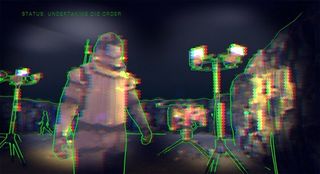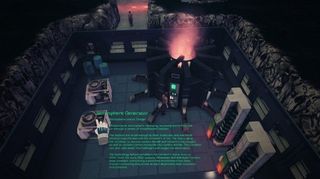Maia preview: battle with starvation and psychosis in this smart SF survival sim

Simon Roth's chickens are misbehaving. They're supposed to be a passive food source in his sci-fi god-game, but in the early build he's showing me they're compelled by instinct to waddle into the nearest puddle of lava. The way a thing breaks can tell you much about how it's built, and Maia breaks in very interesting ways.
“Dungeon Keeper meets Dwarf Fortress,” is how Roth describes it, which is apt when you consider that chickens were snacks in Bullfrog's demon management sim, but Maia's systems promise much more than AI programming in the '90s could ever deliver. Dungeon Keeper's hatcheries churned out brainless sprites. In Maia, chickens have minds of their own.
"In Maia, chickens have minds of their own."
“They'll seek out warmth,” Simon explains. “It's cool because chickens do do that, and it means they'll try and crawl inside reactors and stuff. The bug at the moment is the lava is the brightest, hottest thing in the game.”
The sombre exodus that occurs when a worker robot exposes some magma is both tragic and darkly amusing. It won't happen like that in the finished game, of course, but this cocktail of horror and humour is exactly what Roth and his team are trying to capture. It's a sandbox comedy-of-errors simulator set on a space colony inspired by '70s hard sci-fi.

Maia is the name of the primordial planet that wants to kill you. With the help of a floating cursor-claw and an elevated, godly perspective, you must sustain a small human colony on a vicious, procedurally generated slab of alien terrain. Decompression, solar flares, nuclear meltdowns and mental breakdowns can all scupper a colony in minutes, and the surface world is populated by indigenous beasties only too happy add humans to their diet.
"Nuclear meltdowns and mental breakdowns can scupper a colony."
Underground dwellings provide an uneasy solution to some of these problems. Loyal 'imp' robots can carve rooms into the planet's crust and mine ore to build better equipment. The surface presents two square kilometres of dangerous alien tundra, but Maia's crust is also two kilometres deep. You have a choice: create an insulated warren and risk starvation, or raid the surface world and face the dangers of the wild.
Either way, you'll need power to sustain a breathable atmosphere. The movement of energy through Maia's ecosystem is precisely simulated. The efficiency of solar panels will alter depending on cloud cover and rainstorms. The rate at which surface foliage grows is decided by how much rainand sunlight they receive. All commodities – power, food, research – can be stored, moved and destroyed.
PC Gamer Newsletter
Sign up to get the best content of the week, and great gaming deals, as picked by the editors.
“Everything. Everything is simulated,” Roth says enthusiastically. “As soon as a new bit of grass pops up that's a new thing in the world. It exists and the colonists are aware of it.” That may sound minor, but it reflects the design philosophy that informs every aspect of Maia. Plants aren't just textures, they're entities, which means colonists and creatures can use them and form associations with them. The same goes for lights, sounds and even furniture.

“I can make people afraid of concepts. It lets us do really crazy things. We can make imp bots that hate doors. They hate doors and they'll go trash an airlock and blow out the base.”
"When he dug into the animal's traits he discovered that the cat was an alcoholic."
All the humans, aliens and pets in Maia's sandbox have personalities, governed by a web of needs and procedurally generated histories. They're a bit like Sims, but more autonomous, and mad. Living with hunger and filth will increase the risk of mental collapse, which can mean a murderous psychotic break, or eccentric inaction. Rather than delivering direct orders to your people, you create a command and someone fulfils it. If a colonist is depressed or petrified by door-phobia they might not respond. You can tweak their mood subliminally using different colours of light and they can take mood boosts from relaxation and pets.
Here Maia's layers of simulation trigger another emergent misfire. Roth tells me about a recent playtest in which he observed a cat acting strangely. It was only when he dug into the animal's traits that he discovered that the cat was an alcoholic.
That's why Maia is exciting. There's a rich logic behind the impulses that make chickens walk into lava and cats raid ration packs in search of booze. These broken moments show that Maia's confluent simulation systems are capable of producing narrative. The behavioural system is forming attachments with the resource system and producing an event – in this case: “the cat is getting wasted on petrol.” If it all comes together, Maia could be a truly extraordinary story generator
Part of the UK team, Tom was with PC Gamer at the very beginning of the website's launch—first as a news writer, and then as online editor until his departure in 2020. His specialties are strategy games, action RPGs, hack ‘n slash games, digital card games… basically anything that he can fit on a hard drive. His final boss form is Deckard Cain.
Most Popular





